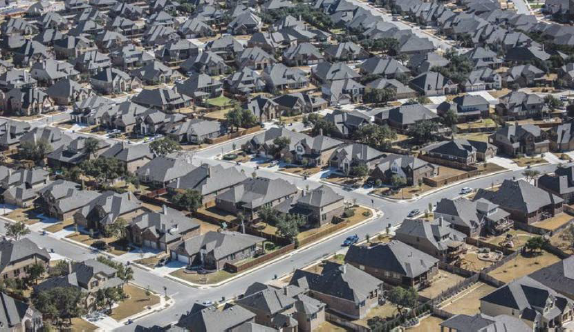America’s rapid population growth, which spiked during the 2021-2024 border surge, has worsened our nation’s affordable housing crisis. Americans who are looking for a house or apartment are being squeezed by rising housing costs, due to inflation and elevated interest rates. They also face greater competition from a growing number of prospective homeowners and renters, especially in fast-growing urban areas.
Even before the most recent surge in immigration, the U.S. was already way behind the demand for affordable apartments. The total number of apartments declined by 4.7 million from 2015 to 2020, according to a report from the National Multifamily Housing Council. The report found that immigration is a significant driver of apartment demand, which has been corroborated by rents for apartments climbing to all-time highs in cities with large numbers of immigrants.

A new housing development in Austin, Texas. See our fact sheet on housing.
People all across the country are worried that the dream of homeownership is slipping away. For too many hardworking families, rising costs, limited housing supply, and growing competition from rapid population growth are putting homeownership out of reach. According to a 2023 LendingTree study, “94% say owning a home is part of the American dream; 51% fear they never will.”
The housing crisis is most pronounced in cities, because employment opportunities bring high rates of population growth. But the housing supply can’t keep pace because of limited land availability, high land prices, and rising construction costs. This mismatch is driving rents up and is pricing families out of the communities where they work.
The lack of affordable housing shows how unsustainable immigration impacts Americans unequally. Blue-collar workers are more vulnerable to mass immigration because they are more likely to live in rental housing. They’re thus more likely to be in direct competition with migrants not just in the job market, but in the housing market as well.
The recent and massive inflow of illegal migrants (8.3 million under the Biden administration) is yet another reason why younger U.S. workers are losing hope of ever buying a home. According to the New York Federal Reserve’s Survey of Consumer Expectations, the share of renters who expect to own a home recently dropped to 40.1 percent. That’s down from 44.4 percent a year ago and the lowest since the annual survey was launched in 2014.
In addition to increasing housing costs, mass immigration also is a major contributor to urban sprawl. Even back in 2017, the Urban Institute found that while inflows of immigrants caused a significant increase in home prices and rents in big cities, the areas surrounding those cities experienced even more cost inflation. Immigration thus drives both densification within our cities plus sprawling growth well beyond.

Sprawling development in Houston. See our Texas Sprawl Study from 2023.
These harsh housing trends will persist as long as immigration rates into America remain high. Tragically, Congress remains unable or unwilling to advance rational immigration policies. Even before the 2021-2024 surge, the Census Bureau projected the U.S. population to grow another 50+ million people by the Year 2060, with more than 90 percent of that growth due to immigration.
NumbersUSA is promoting federal legislation to humanely reduce immigration — our six great immigration solutions. One of the key bills, designed to end the exponential growth of chain migration, is the Nuclear Family Priority Act (H.R.2705 / S.1328). It would end the automatic right for extended family members to immigrate to the U.S., restricting this right to spouses and younger children.